Waking up to the sound of birds is an ideal way to start your day–unless those birds are woodpeckers.
With their incessant tapping and tendency to damage property, it’s easy to see why many consider them as pests.
However, these birds are protected by environmental laws in recognition of their critical role in ecosystems.
So let’s find out how to get rid of woodpeckers effectively yet humanely.
1. Remove The Food Source
One of the primary reasons woodpeckers will fixate on the house is because it is harboring food within its walls.
These birds are omnivores, and a major part of their diet is insects. Ant, termite, and bee infestations are common motivations for a woodpecker pecking on a house.
To confirm if insects are indeed the root of your woodpecker problem, there are a number of things you should do:
- Examine the appearance of the holes. When these birds forage for critters, the holes they drill are typically small, deep, and arranged in horizontal or vertical rows.
- Check the surrounding areas for the signs of infestation. It could be dead insects leftover from the bird’s hunting spree, ant nests, beehives, or wood eaten by termites. Ditto if you actually see living insects crawling on the walls.
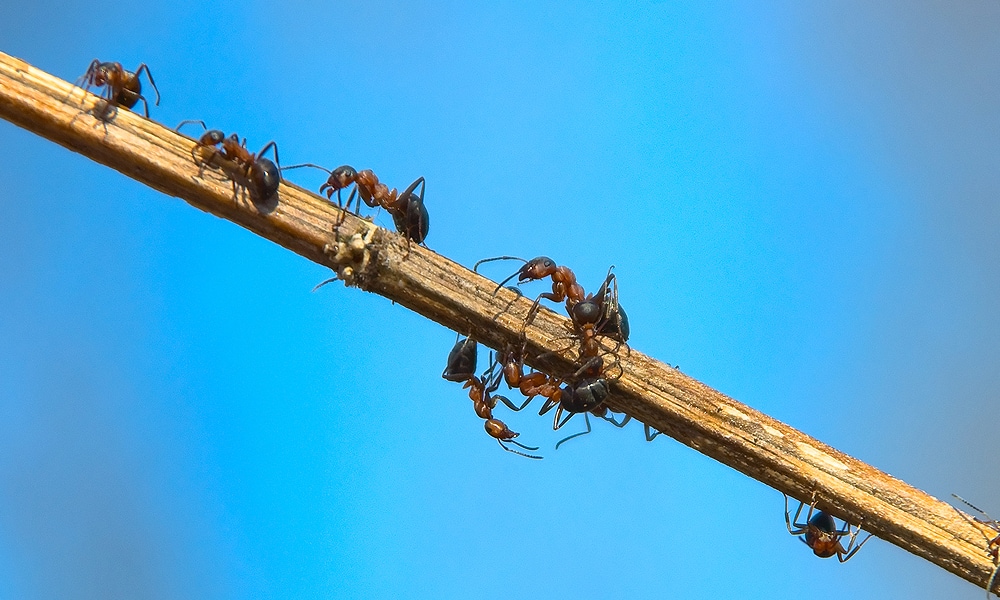
If all signs point to insect infestation, then the best way to stop woodpeckers from pecking house will be to eliminate their food source.
Use pesticides that are specific to the target insect but have minimal effect on other living creatures.
Follow safety protocols on the label to prevent your family and pets from accidentally inhaling, ingesting, or touching the chemicals.
For heavy infestations, you may need to call professional exterminators.
2. Use a decoy woodpecker feeder
To further discourage woodpeckers pecking your house, lure them far away by giving them tasty treats in a woodpecker feeder.
This is a good option if your woodpecker pecking problem is rooted in foraging and nesting behavior—these birds like living close to their food source.
By giving them a better source of food far away from your home, you encourage them to nest far away from your home too.
The most effective decoy woodpecker feeders use suet. Suet cakes are made of rendered animal fat mixed with seeds, vegetables, fruits, and insects.
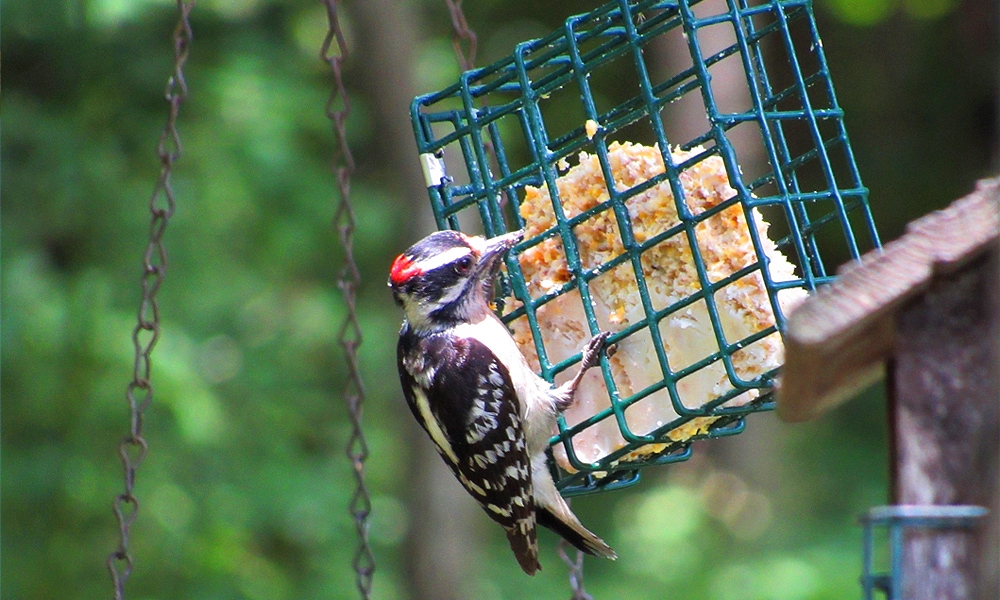
These are solidified into blocks and put in cages called suet feeders. They are typically hung on branches. Birds grip the grills and peck at the food within.
Suet feeders are enticing for woodpeckers because it allows them to feed in their natural position.
Buy a metal suet feeder with a tail prop. Metal is durable and will last a long time. A tail prop allows woodpeckers to be more stable and comfortable as they feed.
When buying suet cakes to get rid of woodpeckers, check the label to see if it is specially made for these birds.
If you decide to make your own, incorporate their favorite food such as black oil sunflower seeds, mealworms, and peanuts.
3. Use a woodpecker sound deterrent
Like most birds, woodpeckers take flight when they hear sounds. Birds have evolved to associate sudden sounds with predators, and taking advantage of that will allow you to scare off woodpeckers without hurting them.
A “woodpecker sound deterrent” is quite a mouthful, but it can be as simple as you clapping your hands or turning the volume up on your speakers. These may be your most economical choice, but it will require effort and consistency to do.
It may be a good idea to alert your neighbors about your anti-woodpecker noise barrage, so they understand what’s the ruckus is about.
If you want a more convenient option, there are a variety of electronic woodpecker deterrents available on the market.
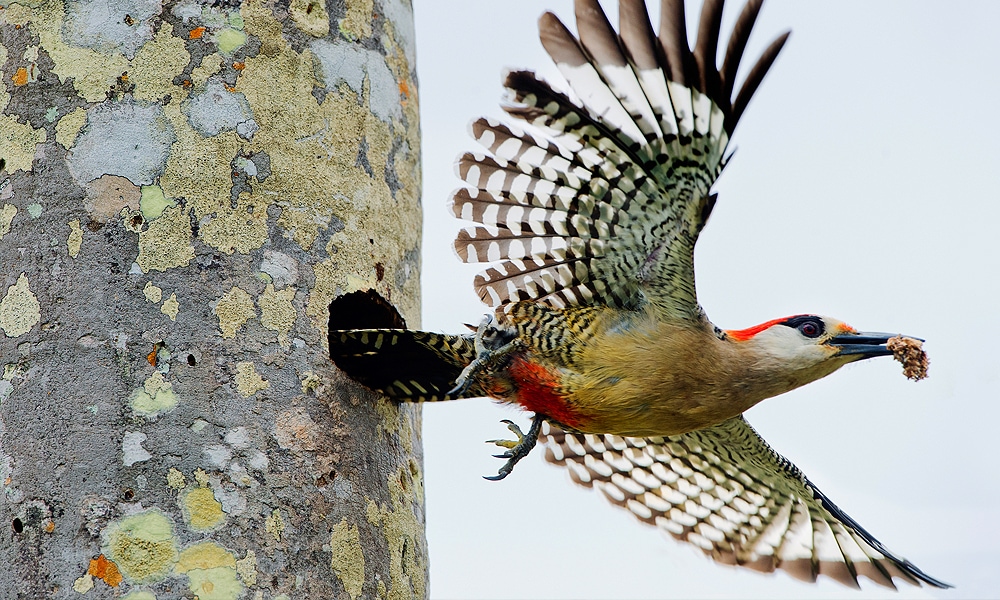
They make use of different techniques to scare woodpeckers away.
The BirdXPeller Pro emits bird distress signals and predator sounds that make woodpeckers think that the area is dangerous. The sounds are prerecorded natural sounds, making it unobtrusive to most neighbors.
Other woodpecker deterrent sound devices make use of high-frequency sounds that can be heard by birds but not humans. These repel woodpeckers because they come off as extremely shrill and annoying.
4. Install a decoy woodpecker predator
A good way to get rid of woodpeckers is to make them think there are predators lurking near your home. So what eats woodpeckers and how do you get those animals to guard your home?
Unfortunately, it’s difficult to train foxes, coyotes, or large birds of prey to keep your home woodpecker-free.
But there are products available that look and move like a woodpecker’s natural predators. These decoys are available in home improvement centers, gardening stores, and online platforms such as Amazon.
The Bird Barrier Rotating Owl Bird Deterrent is a realistic and life-size plastic owl image that can be mounted on any flat surface. It moves with the wind, much like a wind vane does.
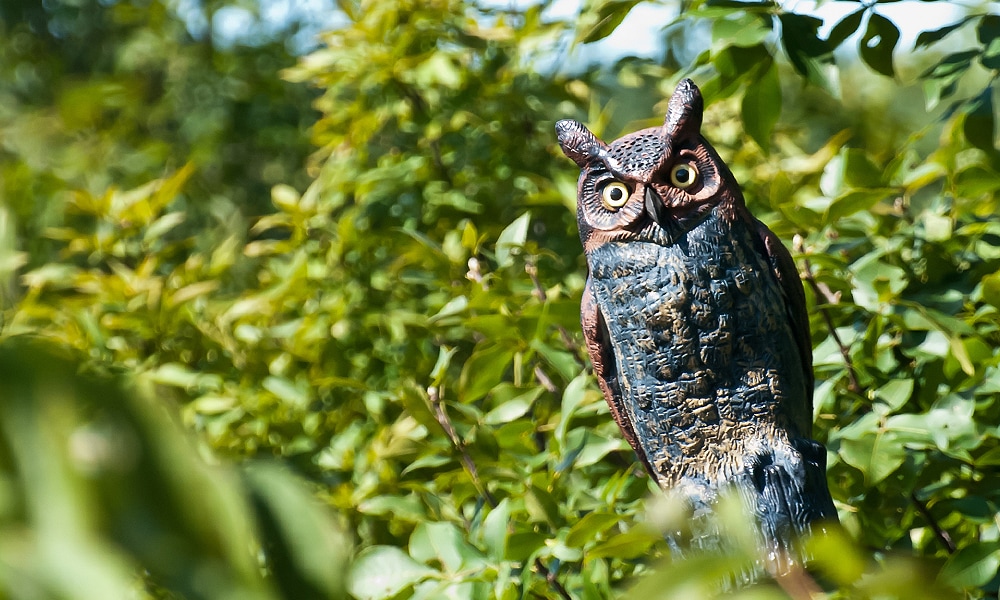
Placing what appears to be a live moving owl near the parts of your home with holes is a good way of deterring woodpeckers from returning to cause more damage.
There are other predator-mimicking woodpecker deterrents on the market today. Some use solar power to make life-like movements to scare birds away.
Others use images of coyotes instead of owls. These are placed half-hidden behind bushes to mimic the natural predatory behavior of these animals.
Getting rid of woodpeckers using decoy predators will require moving them around every 2-3 days to keep up the ruse.
5. Plant strategic fruit trees and berry bushes
Strategic gardening is a good way of discouraging woodpeckers from hammering away at your house.
The first consideration is the location. Choose a planting area that is a good distance away from your home. Avoid planting fruiting trees and bushes right beside the walls of your house.
Keeping them at the perimeter of your property will encourage the birds will congregate there instead of settling into your walls.
Next, think carefully about the kinds of fruits and berries you will plant. Woodpeckers are territorial, so it will take a lot to convince them to move.
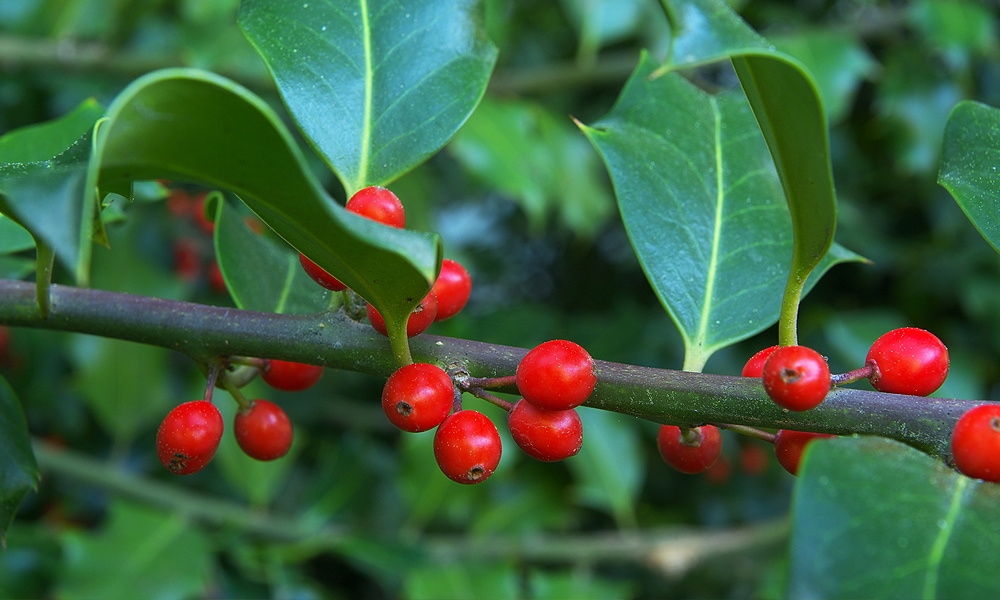
By planting trees and bushes that bear fruit at different months, woodpeckers will want to stay in that area all year-round.
A good tactic would be to plant whatever humans can eat. In doing so you, you hit not two, but three birds with one stone: You satisfy the woodpecker’s sweet tooth, you attract insects that also serve as their food, and you provide fresh and healthy food for your own table.
Seed-bearing flowers, nut-bearing plants, and sap-filled trees are also very effective at stopping woodpeckers from destroying homes. These birds would much rather peck at these than your walls.
6. Install a woodpecker net
Another option to deter woodpeckers from roosting is bird netting. This is the best option for covering large areas. Ideally, the net should rest at least 3 inches above the surface it is covering.
The unstable and soft netting is not ideal for perching, making it a good method for repelling woodpeckers. Make sure to buy bird netting that is specially made for buildings and structures and not the ones made of protecting crops and fish.
Choose rot-proof, water-proof, and UV-proof products to minimize maintenance. It would be a good idea to bring pictures of your home when you visit the store.
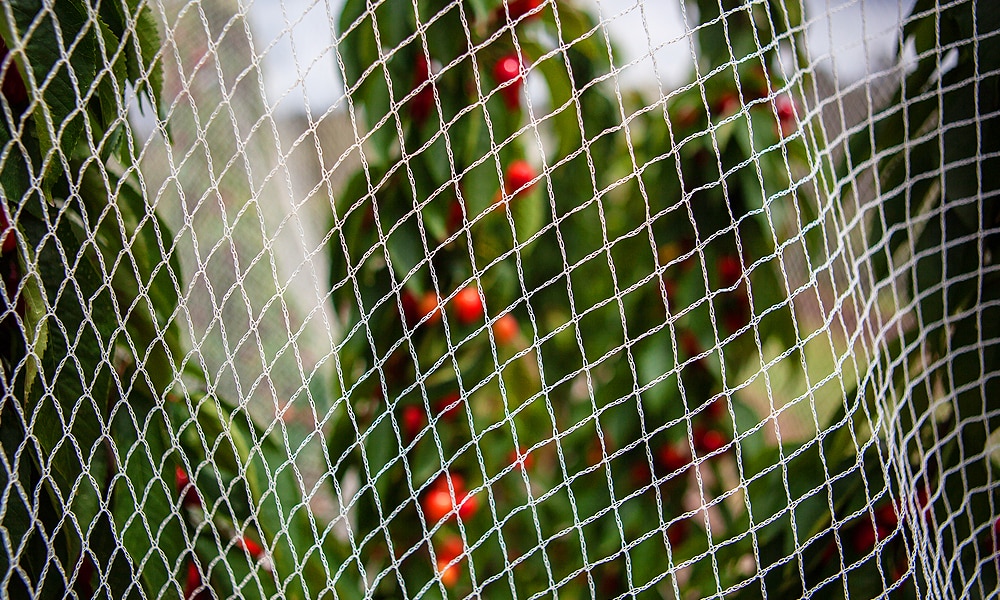
The salesperson may have suggestions on proper installation and ways to make it look more aesthetically pleasing.
Surprisingly, the best woodpecker repellent netting is the one designed to protect against bats. Some species of woodpeckers can be quite large and heavy.
Their force and weight may tear apart conventional bird netting. Bird Barrier 3/8 in. StealthNet 4 / 1 Bat Net is made of knotted polyethylene, making it among the strongest bird netting on the market.
Compared to metal or plastic bird spikes, these require more maintenance. Netting should be checked for holes and tears. Leaves and other debris should be removed periodically.
7. Remove roosting areas
Birds get comfortable with places where they can roost. This includes eaves, fences, roofs, and other horizontal surfaces that are high up.
This familiarity can encourage them to visit more often. If woodpeckers find places to roost in your property, they are more likely to drill holes and create nests in it.
Removing roosting areas is a simple but effective method of woodpecker control and woodpecker prevention.
You can install bird spikes in areas of your home where you see woodpeckers like to hang out. These implements have metal or plastic needle-like rods that jut outward.
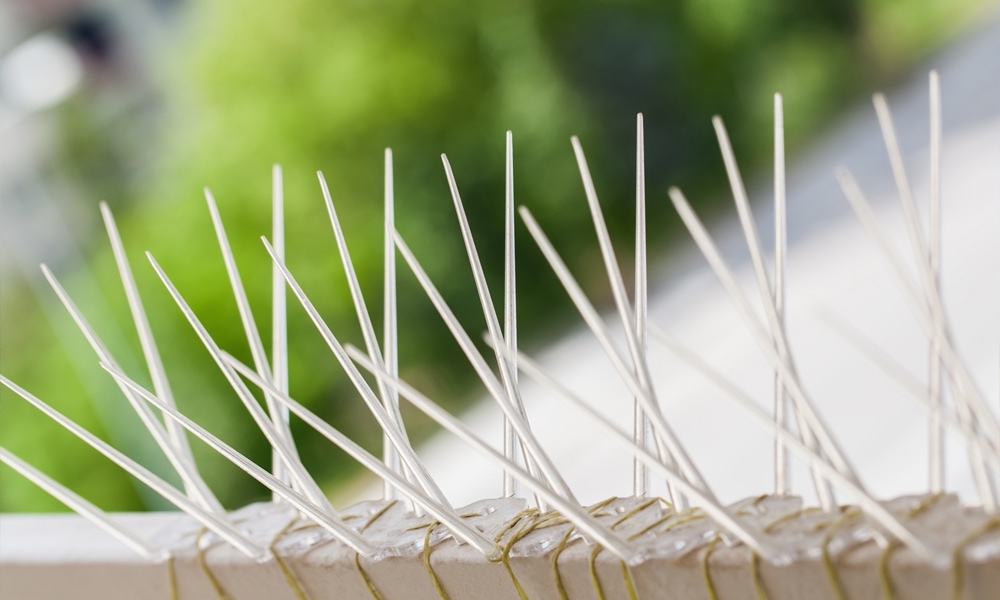
These prevent birds from gripping and settling in. The Bird-Flite Wide Spikes Kit is a good option if you want durable, sturdy, and inconspicuous bird spikes on your home.
This method of repelling woodpeckers are easy to install and do not require much maintenance.
They serve as effective physical barriers to protect your home against woodpecker nesting and roosting. Bird spikes are best arranged in a row to cover ledges, window sills, parapets, and other long horizontal surfaces.
However, many birds are smart enough to avoid spikes and perch in areas where these have not been installed. Some owners may consider them as eyesores.
8. Scare woodpeckers with reflection
Suppose you want to scare away a woodpecker, trying installing things that reflect light. Birds get scared at these shiny, bright objects and tend to avoid them.
If you are wondering how to keep woodpeckers away with reflections, imagine how you’d feel if you suddenly saw bright flashes of light.
Like humans, birds rely on the sense of sight, so shiny, bright objects are especially noticeable and alarming.
The best way to achieve this effect is to hang reflective surfaces on a string and allow them to move in the wind.

The erratic movement catches the sunlight easily, creating sudden bursts of light. You can use anything from old CDs, aluminum foil, or small mirrors. Place them strategically near areas with woodpecker holes.
One of the best woodpecker deterrents is reflective tape. This not only creates striking flashes of light but also creates a crinkling sound in the wind. The visual and auditory stimulation is a one-two punch that scares woodpeckers off.
There are also reflective pinwheels available in garden and home improvement centers. These have stakes that can be driven into the soil. You can use them in your garden or in potted plants located in balconies or windows.
9. Use bright mylar balloons
If you’re scratching your head over how to repel woodpeckers with a bunch of party balloons, we don’t blame you. But if you understand bird behavior, it’s easy to see why this is so effective.
The reasons why mylar balloons make festive party decor are the same reasons why they are so good at getting rid of woodpeckers.
The base material is made of a nylon derivative called mylar that is known for its durability and strength. When used as a woodpecker deterrent, it can stay inflated outdoors for days to weeks, depending on weather conditions.

The outer layer of foil covering the mylar material is shiny and catches the light easily. As if the reflective surface is not enough to scare off woodpeckers, there are woodpecker deterrent balloons that carry images and colors that birds associate with threats.
The De-Bird Balloon Bird Repellent Balloon is a particularly effective woodpecker repellent because it comes with two large eye stickers that were designed to like those of the woodpecker’s natural predators.
To use, simply inflate the balloon, apply the stickers, and hang them near the parts of your home frequented by woodpeckers.
10. Find and fill up holes in your house
To prevent woodpeckers nesting, it is important to cover up any holes that they could use to build their home.
The presence of holes and crevices tells these birds that the wood is soft and easily destroyed–an ideal place to nest. Some may drill at these holes directly to make them wide enough to house their young.
Filling up holes will help in discouraging woodpeckers from carving out their nest into your walls. wood putty, foam, and screens are common options.
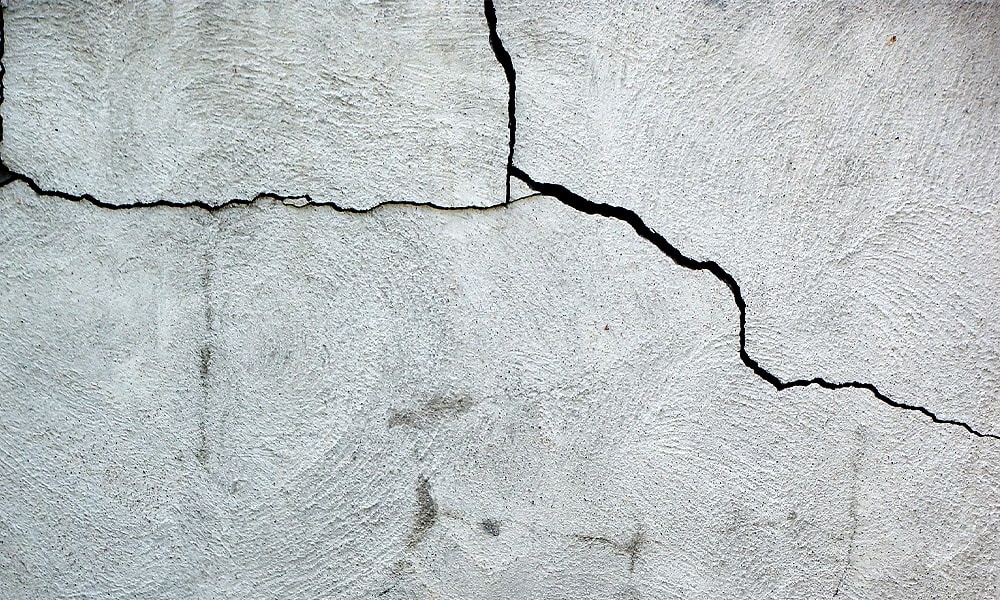
Pur Black Foam is applied by loading the foam into a foam gun and pulling the trigger into the hole you want to fill up.
It solidifies as it dries, leaving a black filling that does not even allow water or gas to pass through–what more, a woodpecker? The surface can be sanded and painted to match your home’s aesthetic.
Stuffit Copper Mesh is made of pliable but strong material that can easily be manipulated to fit into holes of any shape.
Simply cut off a piece, crumple it a little, place it in the crevice, and adjust for a perfect fit. It is best used for holes at most 2 inches in diameter. Because copper mesh is rust-proof and stain-proof, there is little need for maintenance.
11. Wrap the trees
We’ve talked about how to repel woodpeckers from boring holes into your home, but is it any different from figuring out how to stop woodpeckers from damaging your trees?
Trees are the original feeding grounds and nesting areas of woodpeckers. If you are wondering, “Will a woodpecker kill my tree?” the answer is: Not directly.
It is rare for woodpeckers to damage a tree to the extent of killing it, but the holes they bore allows fungus, bacteria, and parasites to enter and weaken the trunk.
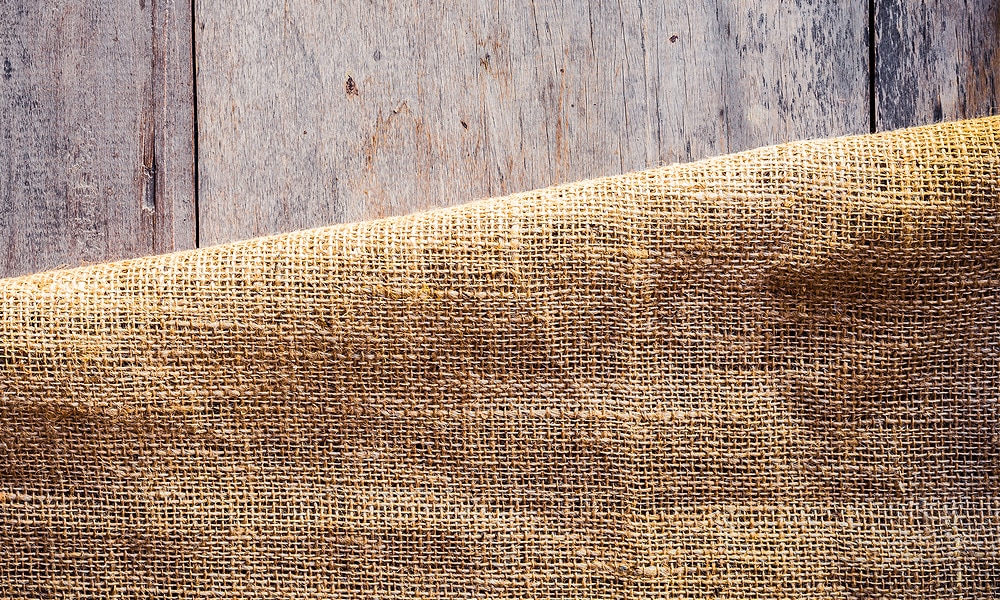
The most often used method to protect trees is to wrap them in the material that deters birds from perching.
NuVue Synlap Synthetic Burlap Roll is one option. This looks like a burlap, which helps it blend with the natural feel of your garden. But it is made of synthetic material that lasts much longer than the hemp fibers of conventional burlap.
It not only deters woodpeckers from gripping the trunk and pecking the wood, but it also protects insects and strong winds, winter burn, and other extreme weather conditions.
It is important to remember that woodpeckers are attracted to rotting and damaged wood. If you see them flocking to trees on your property, it’s a good idea to have them checked for disease.
12. Remove trees near the house
Having trees near your house offers woodpeckers shade from the sun and visual cover against predators—these signal to the bird that the area is a good place to call his own.
The idea of roosting, nesting, and drilling holes into that tree and the surrounding structures suddenly becomes much more attractive.
To eliminate woodpeckers’ presence near your home, you may want to consider cutting down large trees growing right up against your walls, or at least think about pruning its branches.
The lack of tree cover will make these birds feel vulnerable, encouraging them to seek safer spaces.
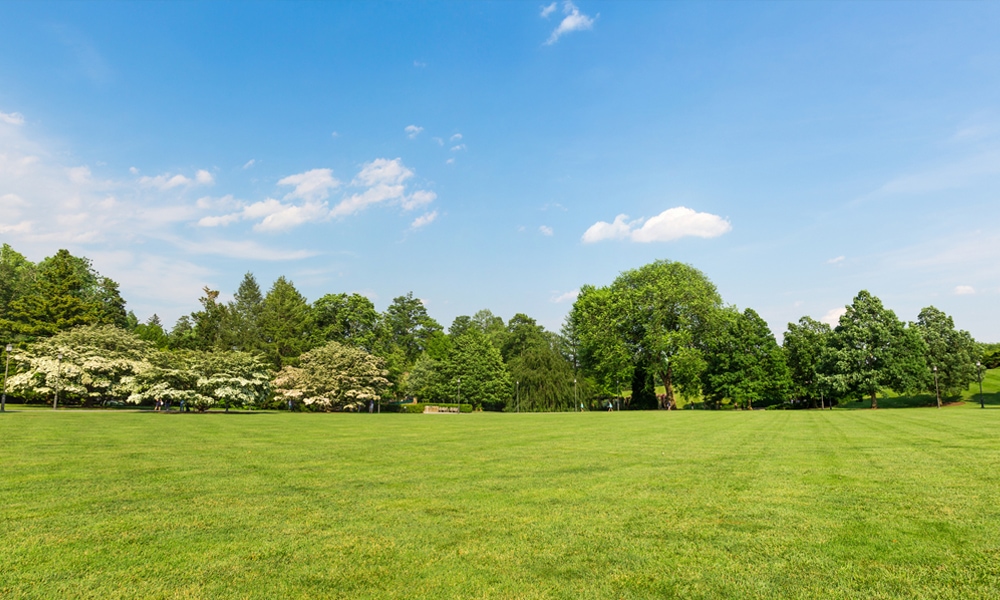
If you are worried that removing trees and branches will dampen the aesthetic of your home and detract other birds and pollinators from visiting your property, consider adding low-lying plants to your garden.
Ornamental shrubs and decorative flowers can be planted near your house, lending it an organic and natural feel while discouraging woodpecker activities.
Instead of planting tall, woodpecker-attracting trees near your house, hark back to tip #3 to and plant them at your property’s perimeter.
You will be able to watch the rustling of the leaves from your window, without having to suffer through woodpecker noise.
13. Add movement do deter woodpeckers
The techniques to address woodpecker problems are not always visually appealing. Some people may think bird spikes, netting, and lifesize pictures of woodpecker predators take away from the beauty of their home.
A good workaround is to find decorative items that move and/or create noise. Take advantage of the fact that sudden, unpredictable movements and loud, unexpected sounds are two of the best woodpecker deterrents.
Flags, streamers, and windsocks are simple, easy-to-install instruments that can scare off woodpeckers.
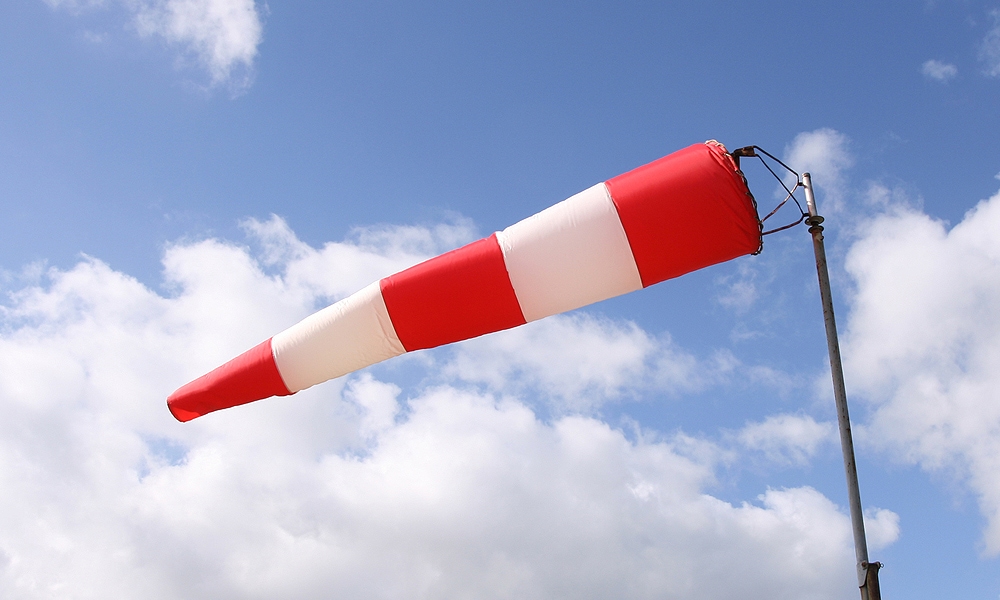
Consider checking your local home improvement store for wind chimes, wind vanes, or other types of garden ornaments that create movement in your yard.
Artists on online platforms may have beautiful pieces that function both as outdoor decor and woodpecker deterrents.
Or take it a step further and make your own woodpecker deterrent slash yard art using reflective tape, aluminum foil, and other shiny, loud materials.
Whichever implement you chose or make, remember that strategic location is everything. Place them near the parts of your home that bear woodpecker pecking marks, or where you usually see woodpeckers roosting.
14. Install a woodpecker house
It may seem counterintuitive to install a woodpecker house when the goal is woodpecker removal, but this is actually one of the most effective methods to resolve this problem.
And while you may not want these birds as house guests, they make useful neighbors. They eat insects that could harm your plants, alert you to the presence of damaged wood, and are quite beautiful to look at.
The best woodpecker houses are those that closely mimic these birds’ natural nests.
Wood is the best material because it is durable and insulates well. It should be unpainted, as woodpeckers do not like bright, unnatural-looking colors.
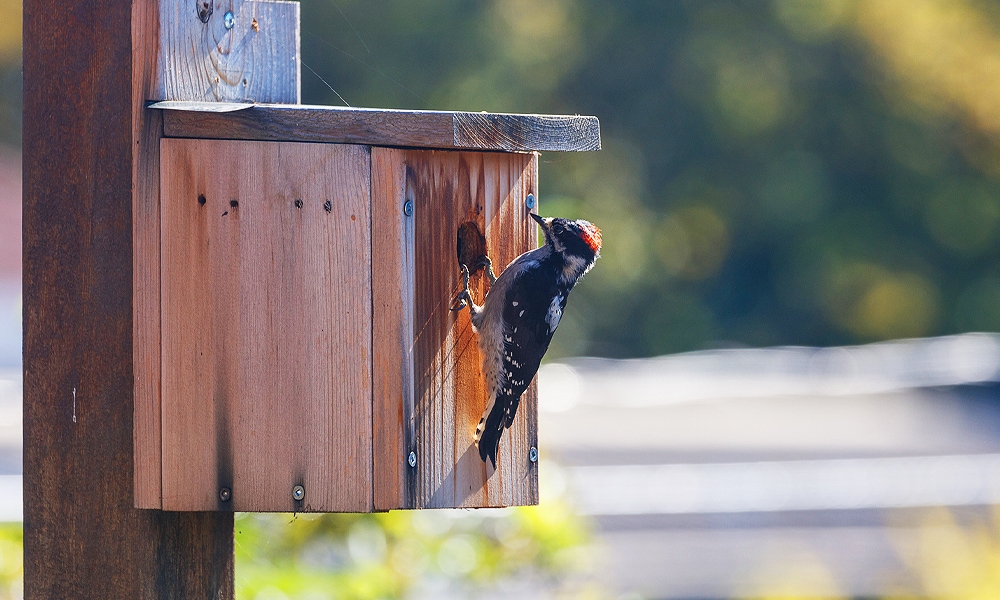
The hole should be big enough to allow woodpeckers in (note that different species may have different sizes). The house must be longer than it is wide, allowing for a deep nest.
It is best to install a woodpecker house on a tree trunk to mimic their natural habitat. If possible, place it near a tree that already bears woodpecker pecking holes.
Make sure to position your woodpecker house far enough from the ground and any footholds to discourage predators.
Add a suet feeder, fruiting trees, and seed-bearing flowers nearby, and you’ve got yourself prime woodpecker real estate that these birds will want to leave your house for.
15. Call a professional
We’ve listed many ways to get rid of woodpeckers and they work best when applied together. In woodpecker control and woodpecker prevention, the whole is greater than the sum of its parts.
But there are cases where even the combination of different woodpecker deterrent methods fail. There may be factors out of your control that make your home irresistible to these birds.
It’s also worth noting that these birds can get territorial. If woodpeckers have called your house home for generations, it will take more than balloons and netting to get them out.
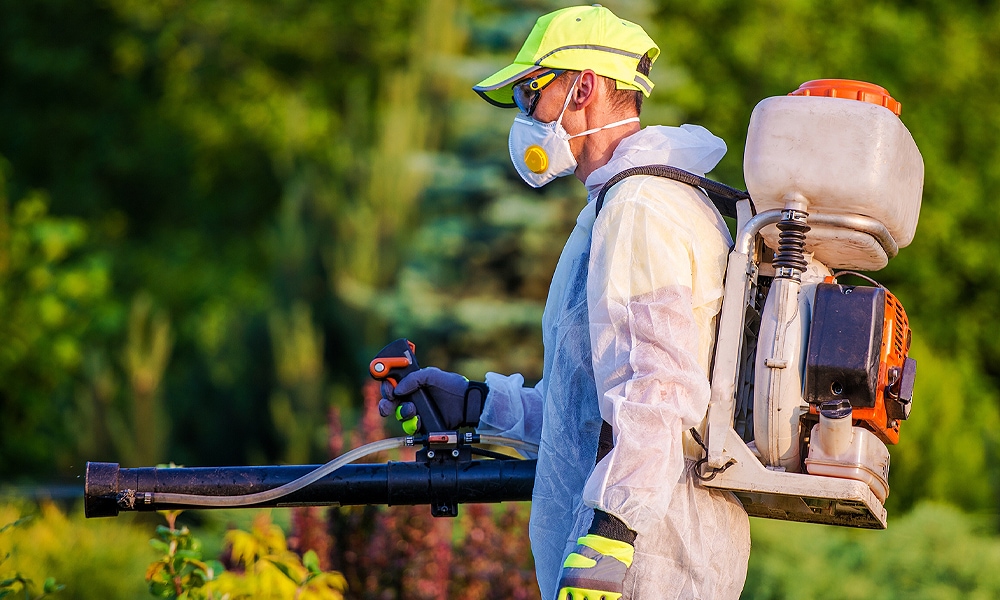
If you’ve tried different methods for at least a month with little improvement, or if the damage to your home is running up the bills and posing a health hazard to your family, then it’s time to call the experts.
Pick a registered pest control company that has a proven track record in resolving woodpecker problems. This way, the expense will be worth it.
Make sure the company you hire complies with environmental laws. A red flag will be if they offer methods to injure, capture, or kill woodpeckers without a proper permit.
Though the use of woodpecker deterrent spray is not illegal, it is frowned upon because of possible toxic effects on the birds and the environment. Woodpecker spray that makes use of sticky chemicals may coat their plumage and result in harm.
Related:

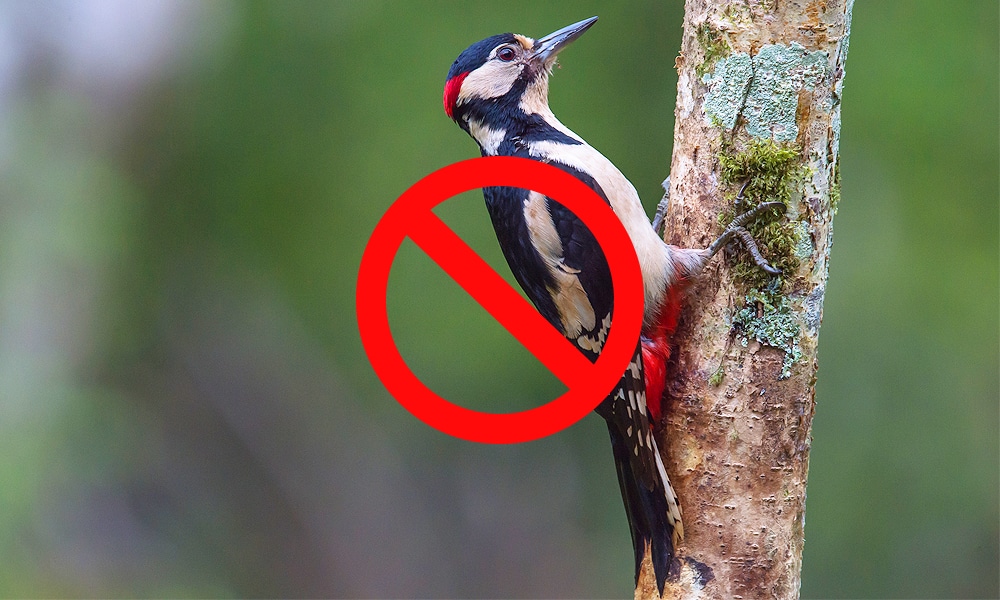
I have tried many different ways to get rid of wood peckers all failed. Be gone for about a week and then come back. Then I started to have very bold skunks come in the yard, and not be afraid of me at all. Well I didn’t want to hurt them, but I do want them the be afraid of me, make them stay out of my yard. So I bought a super soaker squirt gun, wait till the sun started to go down, (because that is when they start coming into the yard.) So I go looking for them and when I see one and they lift there tail I shoot them in the butt and they put there tail down and run off. I did that a few days in a row and haven’t seen them again. So I used this on the wood pecker problem and it worked for him too. I did go out and check the house every night for about a week and he hasn’t come back.
This is working really well and if either one comes back just do it again, until they give up.
I have a woodpecker that just pecks on my home leaving holes. They come every late winter/early spring. They are not building a house in my siding. But, because they have been here, returning every spring, I’m not sure how to get rid of them. I bang on my walls inside to scare them, but they continue to return. Help
Hello, thanks for all the tips except for mylar and KILLING birds. That’s horrible. Please take those off the list. Thanks.
Mylar: terrible idea. Those balloons end up in farmers’ fields, where grazing ungulates eat them and die. Calves are especially vulnerable. If you’ve ever seen a cow licking her calf after it’s choked to death on a mylar balloon, you’ll know what I mean.
Don’t. Use. Mylar.